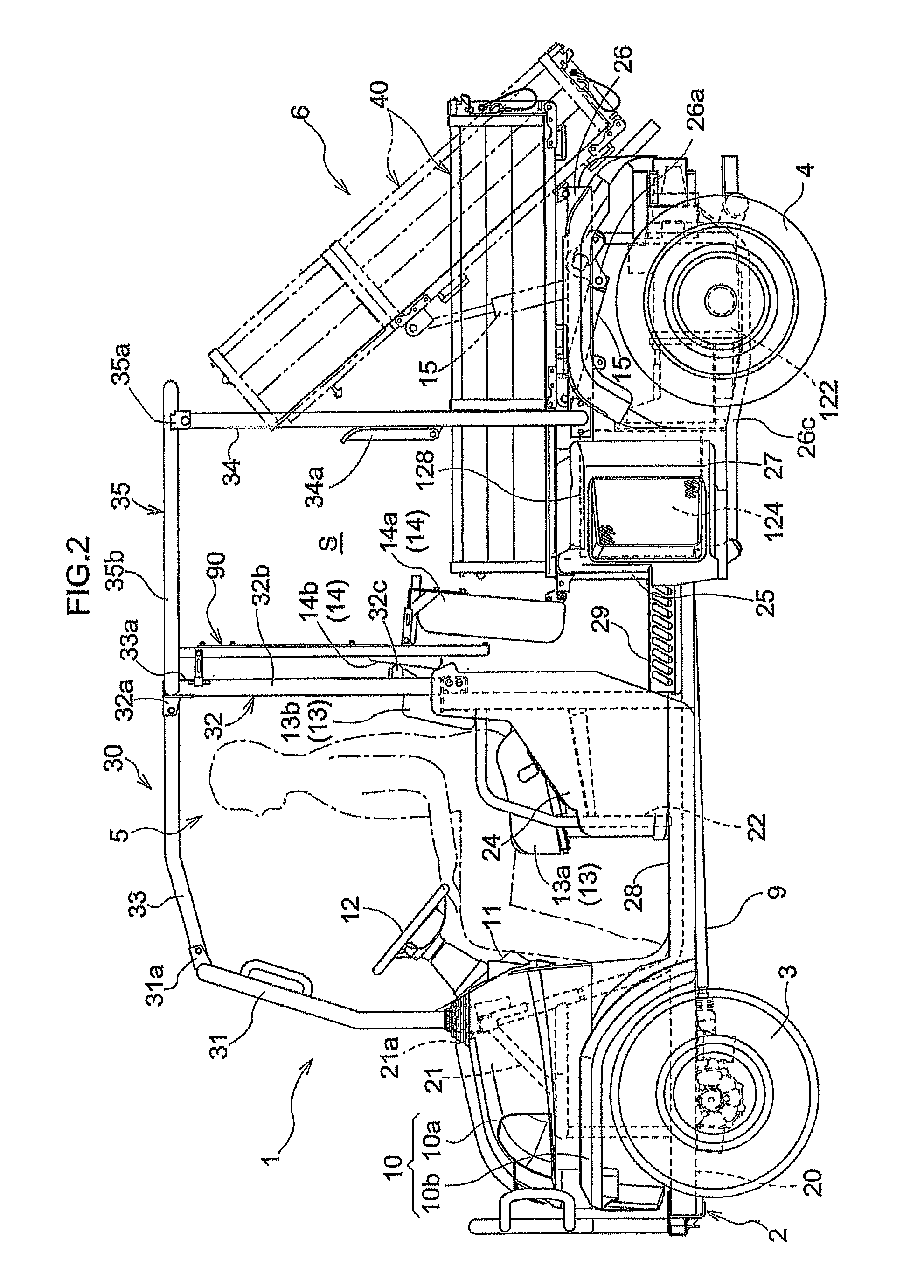Work vehicle
a technology for working vehicles and vehicles, applied in transportation items, pedestrian/occupant safety arrangements, roofs, etc., can solve the problems of insufficient space for disposing of drive units, inability to carry out dumping operations of load-carrying platforms, and troublesome preliminary operations, so as to enhance the ambient air feeding function, enhance the heat exchange function, and reduce the length of the vehicle body.
- Summary
- Abstract
- Description
- Claims
- Application Information
AI Technical Summary
Benefits of technology
Problems solved by technology
Method used
Image
Examples
first alternative embodiment
of the Invention
[0248]In the foregoing embodiment, after the front bottom portion 42 together with the front wall portion 46 is raised rearward and folded, the right and left front side walls 45 are folded to the rear side. Instead, it is possible to employ a different folding order as the order of folding the front wall portion 46, the front bottom portion 42 and the right and left front side wall portions 45. For instance, after folding the right and left front side wall portions 45 to the rear side, the front bottom portion 42 together with the front wall portion 46 can be raised to the rear side and then folded.
[0249]In the foregoing embodiment, by folding the front wall portion 46, the front bottom portion 42 and the right and left front side wall portions 45 rearward, the extended state and the contracted state of the load-carrying platform 40 are realized. Instead, it is possible to employ for the load-carrying platform 40 further constructions shown in FIG. 32A and FIG. 32B....
second alternative embodiment
of the Invention
[0255]In the foregoing embodiment, as the partitioning member 90 is configured to be slidable along the rail members 96, the partitioning member 90 is switchable in position between the forwardly displaced position and the rearwardly displaced position. Instead, a different arrangement can be employed for rendering the partitioning member 90 switchable in position between the forwardly displaced position and the rearwardly displaced position. Specifically, the partitioning member 90 can be constructed as detachably attached type such that the partitioning member 90 at the forwardly displaced position and the rearwardly displaced position can be detachably attached to the ROPS 30 and with detachment of the partitioning member 90 fixed to the ROPS 30 at one of the forwardly displaced position and the rearwardly displaced position, this removed partitioning member 90 is fixed to the ROPS 30 at the other of the forwardly displaced position and the rearwardly displaced po...
third alternative embodiment
of the Invention
[0256]In the foregoing embodiment, the partitioning member 90 at the forwardly displaced position and the rearwardly displaced position is fixed to the ROPS 30. Instead, it is possible to employ a further construction wherein the partitioning member 90 at the forwardly displaced position and the rearwardly displaced position is fixed to the vehicle body. For instance, the partitioning member 90 at the forwardly displaced position and the rearwardly displaced position can be fixed to the vehicle body frame 2, the front seat supporting panel 24, the rear deck plate 29, etc. Or, a further frame member (not shown) other than the ROPS 30 can be extended from the vehicle body frame 2, the front seat supporting panel 24, the rear deck plate 29, etc. and to this frame member, the partitioning member 90 at the forwardly displaced position and the rearwardly displaced position can be fixed.
[0257]Further alternatively, the partitioning member 90 at one of the forwardly displace...
PUM
 Login to View More
Login to View More Abstract
Description
Claims
Application Information
 Login to View More
Login to View More - R&D
- Intellectual Property
- Life Sciences
- Materials
- Tech Scout
- Unparalleled Data Quality
- Higher Quality Content
- 60% Fewer Hallucinations
Browse by: Latest US Patents, China's latest patents, Technical Efficacy Thesaurus, Application Domain, Technology Topic, Popular Technical Reports.
© 2025 PatSnap. All rights reserved.Legal|Privacy policy|Modern Slavery Act Transparency Statement|Sitemap|About US| Contact US: help@patsnap.com



